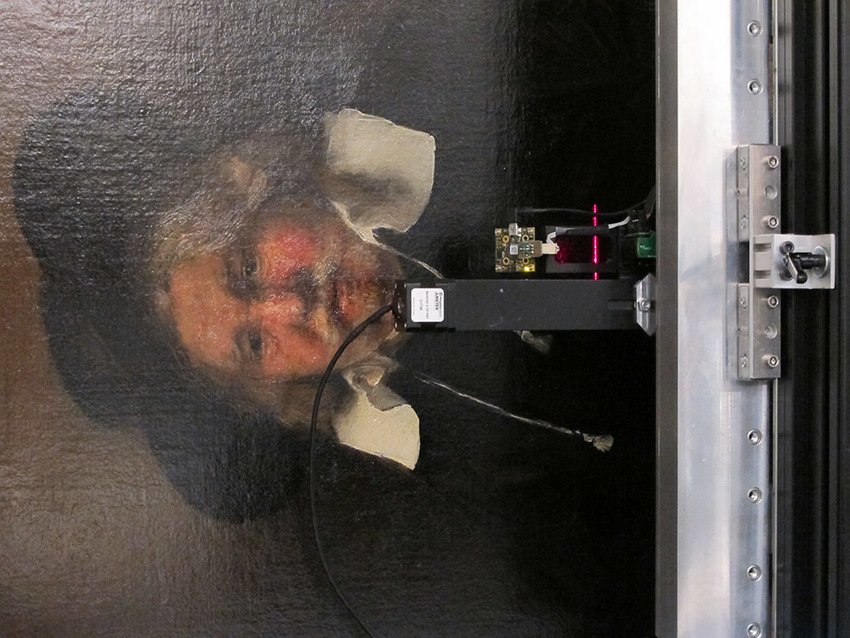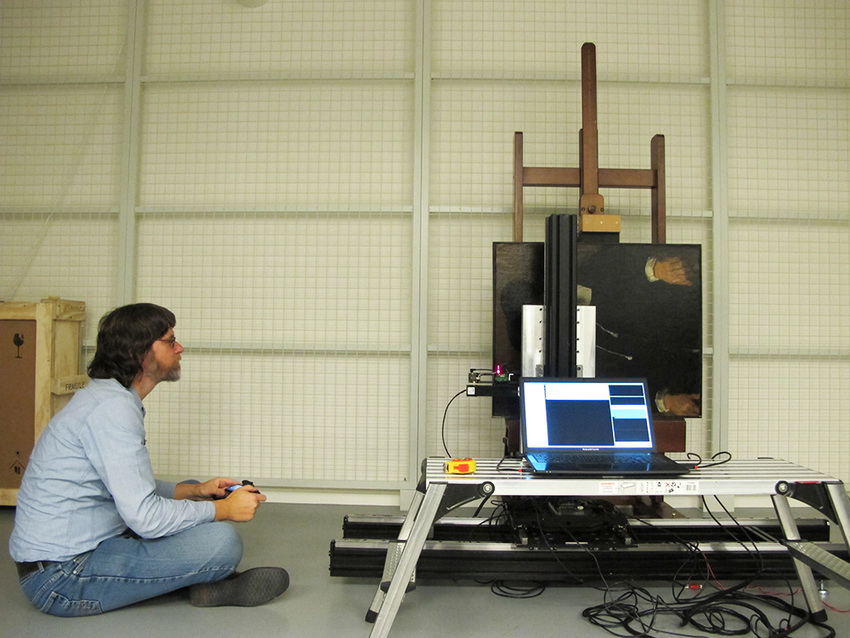This project, which resulted in further collaborations with Canon Production Printing, consisted of recording the original painting’s relief and colour, carried out by a Factum Foundation team in The Hague. Both data sets were then used by CPP to create an exact 3D reproduction.
The recording was undertaken at the Mauritshuis in December 2018, with the Lucida 3D Scanner employed to capture the relief of the canvas and panoramic composite photography carried out for the colour. The Lucida 3D Scanner, designed and built through a collaboration between artist and engineer Manuel Franquelo and Factum Foundation, is specifically designed for recording objects like this artwork. In cases where the shallow relief of a canvas painting is combined with large dark areas and a glossy varnished surface. Lucida is, to date, the only system capable of providing 3D data with the closest correspondence to the original.

The Lucida 3D Scanner digitising the surface of Rembrandt’s Portrait of an Elderly Man © Factum Foundation and Canon Production Printing
The Lucida had been used to scan more than 180 paintings across museums, cultural institutions, and archaeological sites worldwide prior to its application on this digitisation project. The obtained information is fundamental for monitoring the conservation state of cultural artifacts as well as for the creation of exact facsimiles. It is essential that the recorded digital information can retain the unique character of the original surface when reproduced, and it is in this critical transformation step where the collaboration between Factum Foundation’s recording systems and CPP’s Elevated Printing technology is leading the path in the heritage preservation field.
The 82 x 68 cm dimensions of the canvas took around 4 hours to record using the Lucida 3D Scanner. Lucida is a non-contact 3D scanner that operates from a constant distance of about 10 cm from the painting. It generates 3D information in various formats, including a shaded render and a greyscale depth map, both as TIF formats. This information can be combined with the colour panorama to create a multi-layer file both for on-screen inspection and for physical output with CPP’s technology.
The colour recording was carried out with panoramic composite photography. With this technique, hundreds of high-resolution shots taken from a single point are combined together to form a single image file with a resolution of around 500ppi. The painting was photographed from a distance of about 6m, using two flash units positioned at both sides of the line of shooting. Three different shooting positions were incorporated: one for each light unit and one that involved them both; this was in order to balance the reflections caused by the flash and result in a harmonious set of data.
Concurrently with the scanning and production of the facsimile, Factum Foundation has developed a multi-layered browser that enables the visualisation of the scanned relief and colour data of the painting at an extremely high resolution, allowing the inspection of every single detail from any computer screen. This digital viewer has the potential of engaging new audiences in appreciating the complex nature of artworks, and helps conservators, restorers and researchers to understand the current preservation state of paintings.
See the multi-layered browser of Rembrandt’s Portrait of an Elderly Man here:
The high-resolution colour and relief information recorded by the Factum Foundation was used by Canon Production Printing to create a replica with Elevated Printing technology, which was presented to the Mauritshuis in January 2019.
Canon Production Printing’s Elevated Printing Technology allows the creation of full-colour textured prints with a maximum size of 2.44 x 1.19m and a height of up to 5mm. The technology employs a UV-curable ink and involves multiple layers of this being stacked on top of each other. After each layer, the ink is fixed and cured before the next layer is applied. The thickness of each layer varies between 2 and 4μm. This results in texture created with extremely high precision in all dimensions. To create full-colour elevated prints the texture layers are covered with a white layer. On top of this, a colour layer is applied.
Full-colour texture data consists of a CMYK or RGB bitmap for colour and a 16-bit grayscale height map for elevation/texture. The full-colour texture data is fed into the Elevated Print Raster Imaging Processor. The RIP creates a stack of image files to be printed one by one on top of each other in order to create the full colour textured print.



















